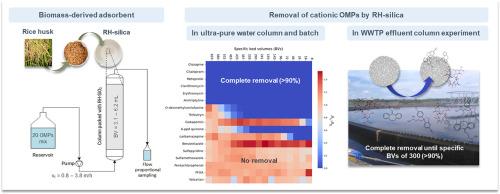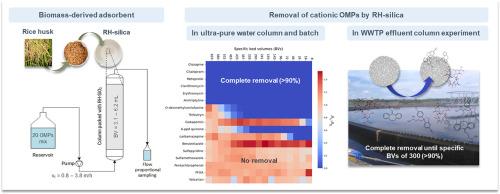Charge as a key physicochemical factor in adsorption of organic micropollutants from wastewater effluent by rice husk bio-silica
IF 11.4
1区 环境科学与生态学
Q1 ENGINEERING, ENVIRONMENTAL
引用次数: 0
Abstract
Wastewater treatment plants (WWTPs) often fail to fully remove organic micro-pollutants (OMPs), necessitating advanced treatment methods. This study examines the potential of an agricultural waste-derived adsorbent, rice husk (RH) – silica, for removing a complex mixture of 20 OMPs in MilliQ water and wastewater effluent. While RH-silica shows potential for OMP removal, its performance with multicomponent mixtures in real wastewater has yet to be investigated. Batch experiments demonstrated the efficacy of RH-silica in removing cationic, neutral, polar, and non-polar OMPs across various pH levels, with no adsorption of anionic OMPs. Column elution studies revealed that only positively charged compounds did not reach a breakthrough after 300 specific bed volumes (BVs), even when the filtration velocity was increased fivefold (3.8 m/h) and lower adsorbent-to-volume ratios (0.5 g/L) were employed. This indicates that electrostatic interactions via deprotonated silanol groups are the primary adsorption mechanism. RH-silica's ability to retain cationic pollutants regardless of their hydrophilicity degree highlights its potential as a novel adsorbent targeting positively charged persistent and mobile organic compounds (PMOCs). Moreover, the adsorption efficiency remained high in experiments with real wastewater effluent. Considering practical applications, a RH-silica column could be used to enhance removal of cationic polar compounds. This approach not only improves pollutant removal efficiency but also contributes to sustainability in WWTPs by using agricultural waste resources. Despite significant operational and end-of-life challenges for large-scale implementation, this study represents a crucial advancement in the investigation of RH-silica as an adsorbent.


电荷是稻壳生物二氧化硅吸附废水中有机微污染物的关键理化因素
污水处理厂(WWTPs)往往无法完全去除有机微污染物(OMPs),因此需要采用先进的处理方法。本研究考察了一种源自农业废弃物的吸附剂--稻壳(RH)-二氧化硅去除 MilliQ 水和废水中 20 种 OMPs 复杂混合物的潜力。虽然稻壳-二氧化硅具有去除 OMP 的潜力,但其在实际废水中处理多组分混合物的性能还有待研究。批量实验表明,RH-二氧化硅能有效去除不同 pH 值的阳离子、中性、极性和非极性 OMP,但不吸附阴离子 OMP。柱洗脱研究表明,即使过滤速度提高五倍(3.8 m/h)并采用较低的吸附剂体积比(0.5 g/L),在 300 个特定床体积(BV)后,也只有带正电荷的化合物没有达到突破。这表明,通过去质子化硅烷醇基团的静电相互作用是主要的吸附机制。无论阳离子污染物的亲水程度如何,RH-二氧化硅都能将其保留下来,这凸显了它作为针对带正电荷的持久性和流动性有机化合物(PMOCs)的新型吸附剂的潜力。此外,在实际废水实验中,其吸附效率仍然很高。考虑到实际应用,RH-二氧化硅柱可用于提高阳离子极性化合物的去除率。这种方法不仅能提高污染物的去除效率,还能利用农业废弃物资源,为污水处理厂的可持续发展做出贡献。尽管在大规模实施过程中会遇到操作和报废方面的重大挑战,但这项研究代表了在研究 RH-二氧化硅作为吸附剂方面取得的重要进展。
本文章由计算机程序翻译,如有差异,请以英文原文为准。
求助全文
约1分钟内获得全文
求助全文
来源期刊

Water Research
环境科学-工程:环境
CiteScore
20.80
自引率
9.40%
发文量
1307
审稿时长
38 days
期刊介绍:
Water Research, along with its open access companion journal Water Research X, serves as a platform for publishing original research papers covering various aspects of the science and technology related to the anthropogenic water cycle, water quality, and its management worldwide. The audience targeted by the journal comprises biologists, chemical engineers, chemists, civil engineers, environmental engineers, limnologists, and microbiologists. The scope of the journal include:
•Treatment processes for water and wastewaters (municipal, agricultural, industrial, and on-site treatment), including resource recovery and residuals management;
•Urban hydrology including sewer systems, stormwater management, and green infrastructure;
•Drinking water treatment and distribution;
•Potable and non-potable water reuse;
•Sanitation, public health, and risk assessment;
•Anaerobic digestion, solid and hazardous waste management, including source characterization and the effects and control of leachates and gaseous emissions;
•Contaminants (chemical, microbial, anthropogenic particles such as nanoparticles or microplastics) and related water quality sensing, monitoring, fate, and assessment;
•Anthropogenic impacts on inland, tidal, coastal and urban waters, focusing on surface and ground waters, and point and non-point sources of pollution;
•Environmental restoration, linked to surface water, groundwater and groundwater remediation;
•Analysis of the interfaces between sediments and water, and between water and atmosphere, focusing specifically on anthropogenic impacts;
•Mathematical modelling, systems analysis, machine learning, and beneficial use of big data related to the anthropogenic water cycle;
•Socio-economic, policy, and regulations studies.
 求助内容:
求助内容: 应助结果提醒方式:
应助结果提醒方式:


